Talk to a Registered Dietitian and use INSIDER20 for 20% off!
Talk to a real Dietitian for only $99: Schedule Now
This post contains links through which we may earn a small commission should you make a purchase from a brand. This in no way affects our ability to objectively critique the products and brands we review.
Evidence Based Research To fulfill our commitment to bringing our audience accurate and insightful content, our expert writers and medical reviewers rely on carefully curated research.
Read Our Editorial Policy
Although many people envision snacks as high-calorie, sugary, carb-loaded, or simply unhealthy, that’s not always true.
Well-thought-out, nutrient-rich snacks can actually be an excellent way to get in extra fruits, vegetables, protein, and fiber that may not have made it into your three meals that day.
In fact, many snacks are low-calorie, nutrient-rich, and filling enough to help you make it to your next meal.
Whether you want to lose weight, keep your blood sugar stable, maintain energy, or simply make healthier choices throughout the day, these 15 filling low-calorie snacks are for you.
Healthy snacks are smaller portions of foods rich in vitamins, minerals, and filling macronutrients that can bolster your nutritional intake for the day.
They can also help to bridge the hunger gap between meals, maintaining stable blood sugar and energy.
Healthy snacks can also ensure that you don’t overeat or binge when your next meal comes around (anyone who’s ever shown up to a restaurant starving and ate an entire basket of bread or chips understands this firsthand!).
Research also backs this up: a review study concluded that snack foods have the potential to increase satiety (fullness) after meals, with high-protein snacks having the most beneficial effect. They also reported that high-protein, high-fiber snacks led to reduced caloric intake at the next meal compared to when people ate high-fat, high-sugar snacks.1
An ideal healthy snack should contain at least two of the following factors to be filling:
Carbohydrate-only snacks (like fruit, crackers, chips, cookies, etc.) will likely only keep you full for a short time, but mixing in protein and fat will help with satiety.
For example, snacking on just fruit would check the fiber box, but it does not contain fat or protein. Instead, adding some cheese or nuts to this snack would make it a better option for satiety.
Even some healthy foods (like nut butter, nuts, cheese, olives, and avocado) are higher in calories. That doesn’t mean they can’t be part of your healthy snack—rather, we just want to be mindful of portion sizes (if watching calories is your goal).
Eggs are a perfect package of protein, healthy fats, and vitamins that aren’t found in many other foods (like choline).
While any type of egg preparation is a low-calorie and filling snack, hard-boiling them is the most typical way to snack on them.
Just be sure not to throw out the yolk—while most of the protein is in the whites, the yolks contain healthy fats, vitamin D, and choline.
You can eat hard-boiled eggs plain, add salt and pepper or a dash of soy sauce, or top with hot sauce or another condiment you enjoy.
While hard-boiled eggs are easy to make, many grocery stores sell pre-made options to simplify snack time if you’re in a time crunch.
Nutrition Per Serving:
2 large hard-boiled eggs: 156 calories, 10g fat, 0g carbs, 0g fiber, 12g protein
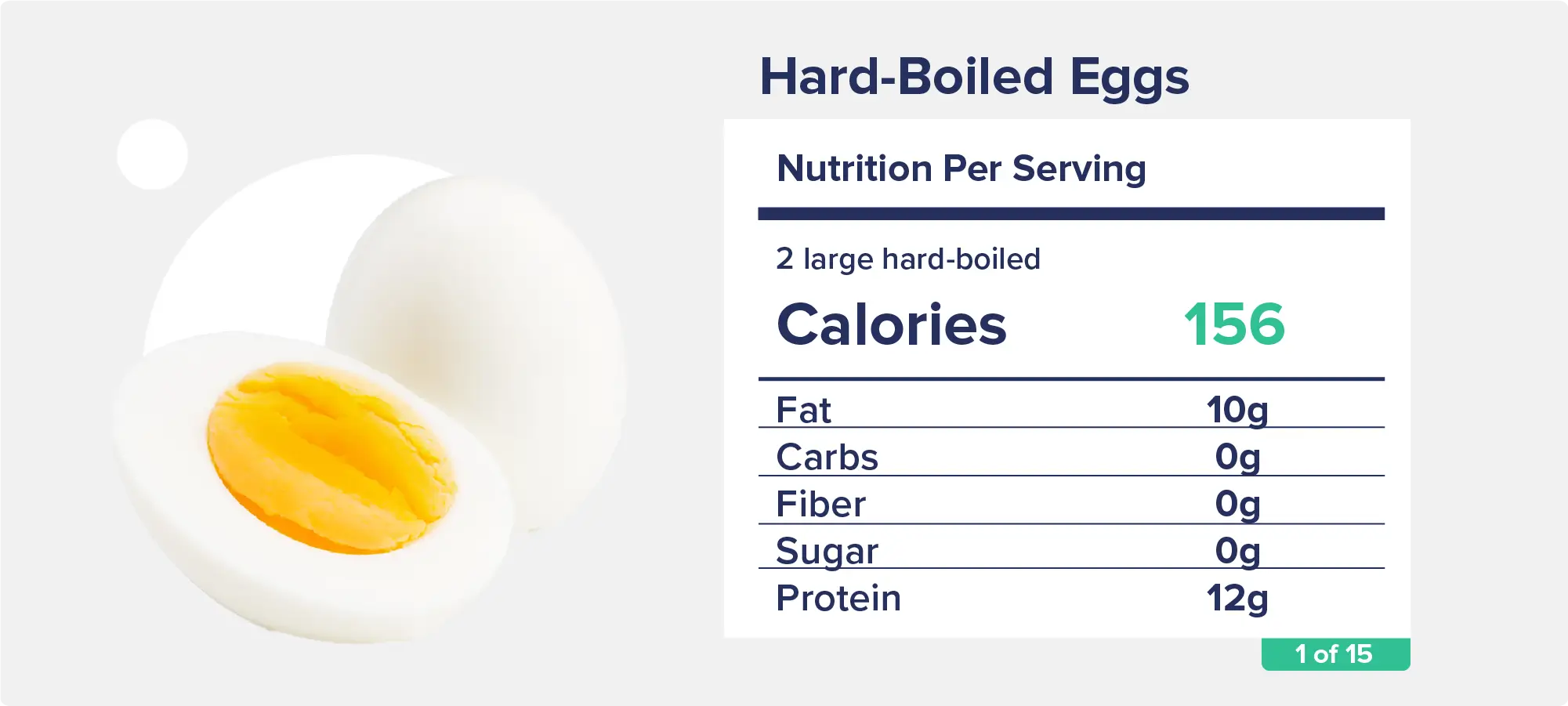
Popcorn on its own is a healthy and fiber-rich whole grain—but it’s the butter (or artificial “butter” topping your movie theater tub) and extra salt that can make popcorn an unhealthy snack.
Air-popped popcorn is simple to make at home, and you can control the toppings you add, like olive oil spray and sea salt.
Plus, popcorn is an example of volumetric eating, which means you can eat a large volume of food for not too many calories.
Nutrition Per Serving:
2 cups of air-popped popcorn: 60 calories, 1g fat, 12g carbs, 3g fiber, 2g protein
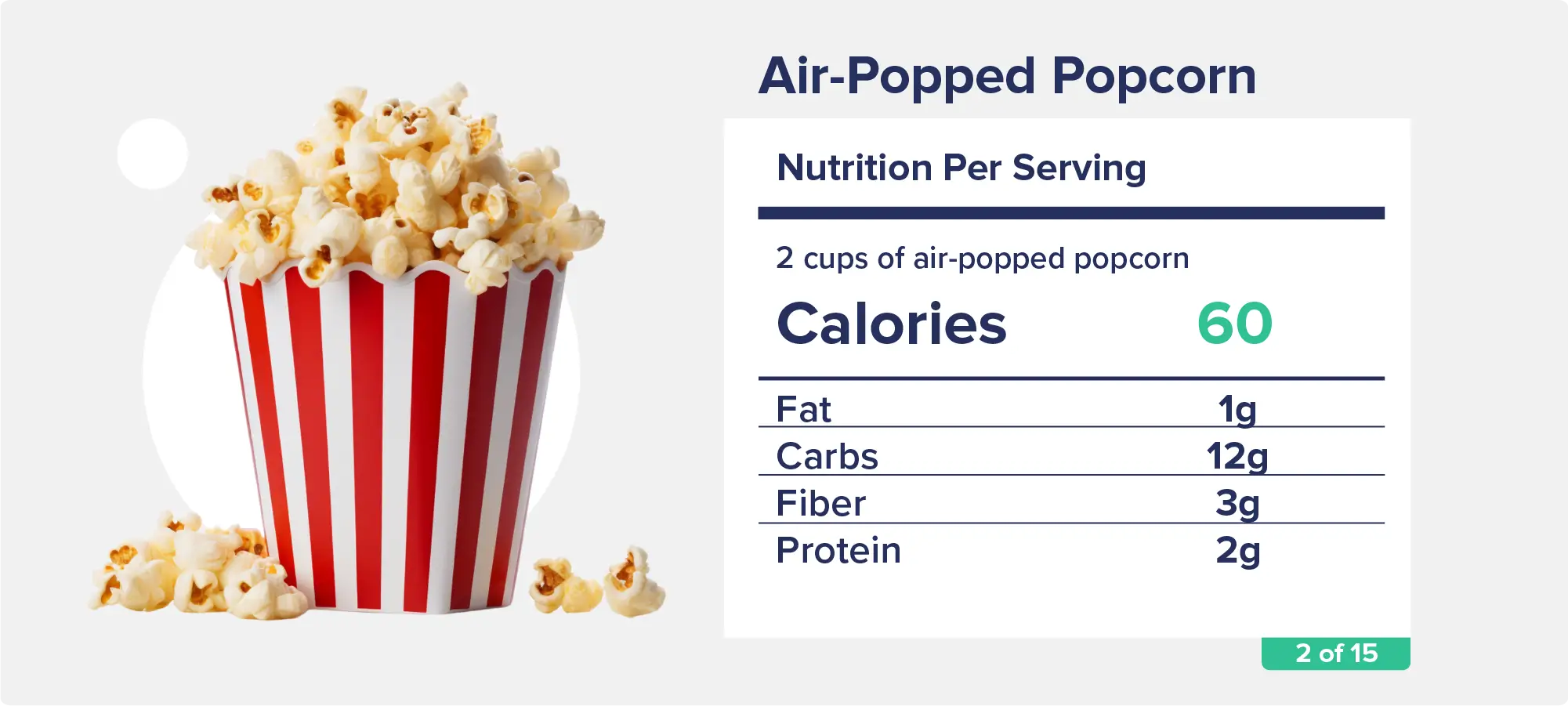
Tuna is known for being rich in omega-3 fats and protein. Even better, canned tuna requires no refrigeration and makes for a quick and satisfying snack.
As tuna is a bit dry on its own, many prefer it tuna salad-style, mixed with mustard, mayonnaise, or even olive oil. Just remember that mayo and olive oil add extra calories (about 100 per tablespoon).
Half a can of tuna can be a filling snack (containing about 120 calories and 11 grams of protein), but an entire can is highly satiating if you’re feeling extra hungry.
Another option is purchasing pre-packaged, single-serve tuna pouches with various seasonings, like this Safe Catch Garlic Herb Wild Tuna Pouch.
If you want crackers, portion the tuna out onto 5-6 whole-grain crackers. Some healthy options are Mary’s Gone Crackers or Simple Mills Almond Flour Crackers for a grain-free cracker.
Nutrition Per Serving:
2.5 oz tuna: 120 calories, 2g fat, 0g carbs, 0g fiber, 11g protein
About 6 crackers: Approximately 70 calories, 2.5g fat, 10g carbs, 1.5g fiber, 2g protein
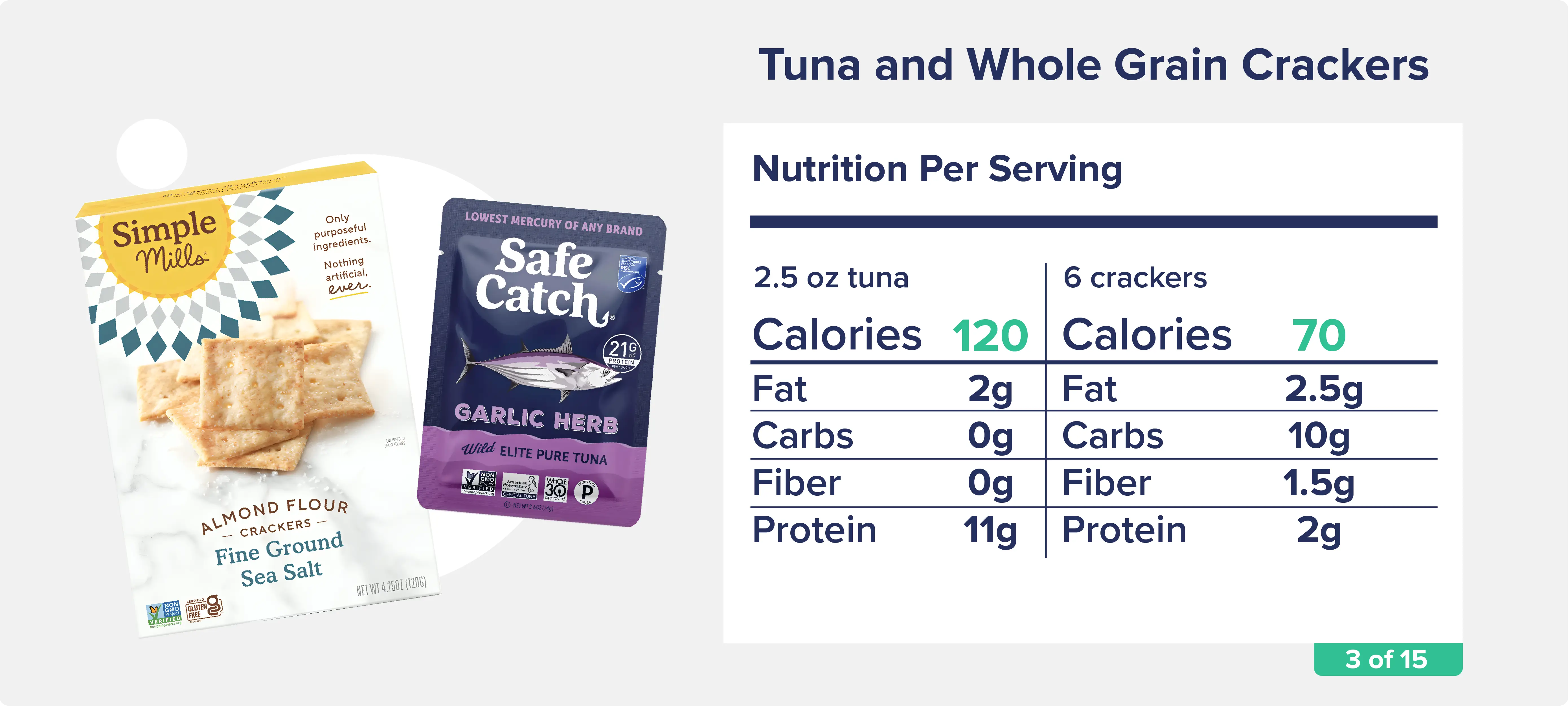
Celery is known in the world of weight loss for its few calories (about 14 per cup) and high water content.
Many people claim that celery is a “negative calorie food,” meaning your body expends more calories to digest it than are actually in the food itself.
However, that’s not entirely true. The energy needed to digest, absorb, and metabolize foods (known as the “thermic effect of foods”) is about 5-10% of the calories that food contains for carbs, 0-5% for fat, and up to 30% for protein.2
Low-calorie foods like celery are almost entirely carbohydrates, so you will only use 5-10% of the total calorie intake to digest it. For example, if you eat 100 calories of celery, you’d only expend 5-10 calories in digestion and absorption.
That said, celery is still a low-calorie food with health benefits, so crunch away!
Spreading crunchy celery with creamy nut butter is a classic way to enjoy the vegetable—try it with peanut butter or almond butter. If you’re allergic to nuts, try dipping celery in tahini, which is made of sesame seeds.
As nut and seed butters are high in calories, stick to about one tablespoon if you’re concerned about your caloric intake.
Nutrition Per Serving:
3-4 large sticks of celery: 30 calories, 0g fat, 6g carbs, 3g fiber, 0g protein
1 Tbsp nut butter: 90 calories, 8g fat, 3g carbs, 1g fiber, 4g protein
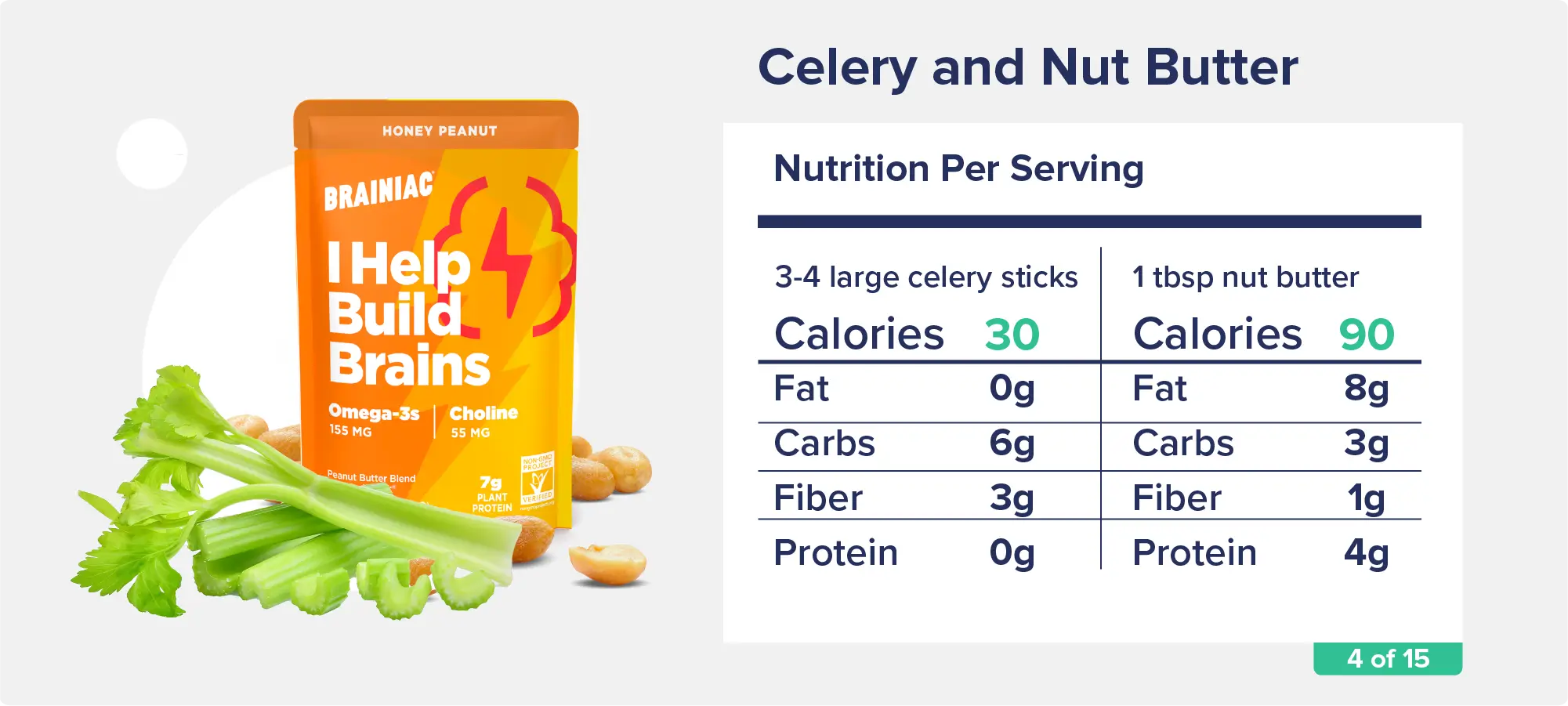
Cottage cheese is loaded with protein—24 grams in just one cup!—and is relatively low in calories, making it an excellent filling snack. Opt for low-fat cottage cheese if you want to keep the calorie count lower and full-fat cottage cheese if you want a more satisfying snack.
Although many people think cottage cheese’s texture on its own has a bit of an ick factor, you can easily blend it into many recipes, savory or sweet.
For a filling snack, mix up 1 cup of cottage cheese with ½ cup of berries or another fruit you enjoy.
Nutrition Per Serving:
1 cup cottage cheese: 200 calories, 9g fat, 7g carbs, 0g fiber, 24g protein
½ cup berries: ~30 calories, 0g fat, 7g carbs, 4g fiber, 0g protein
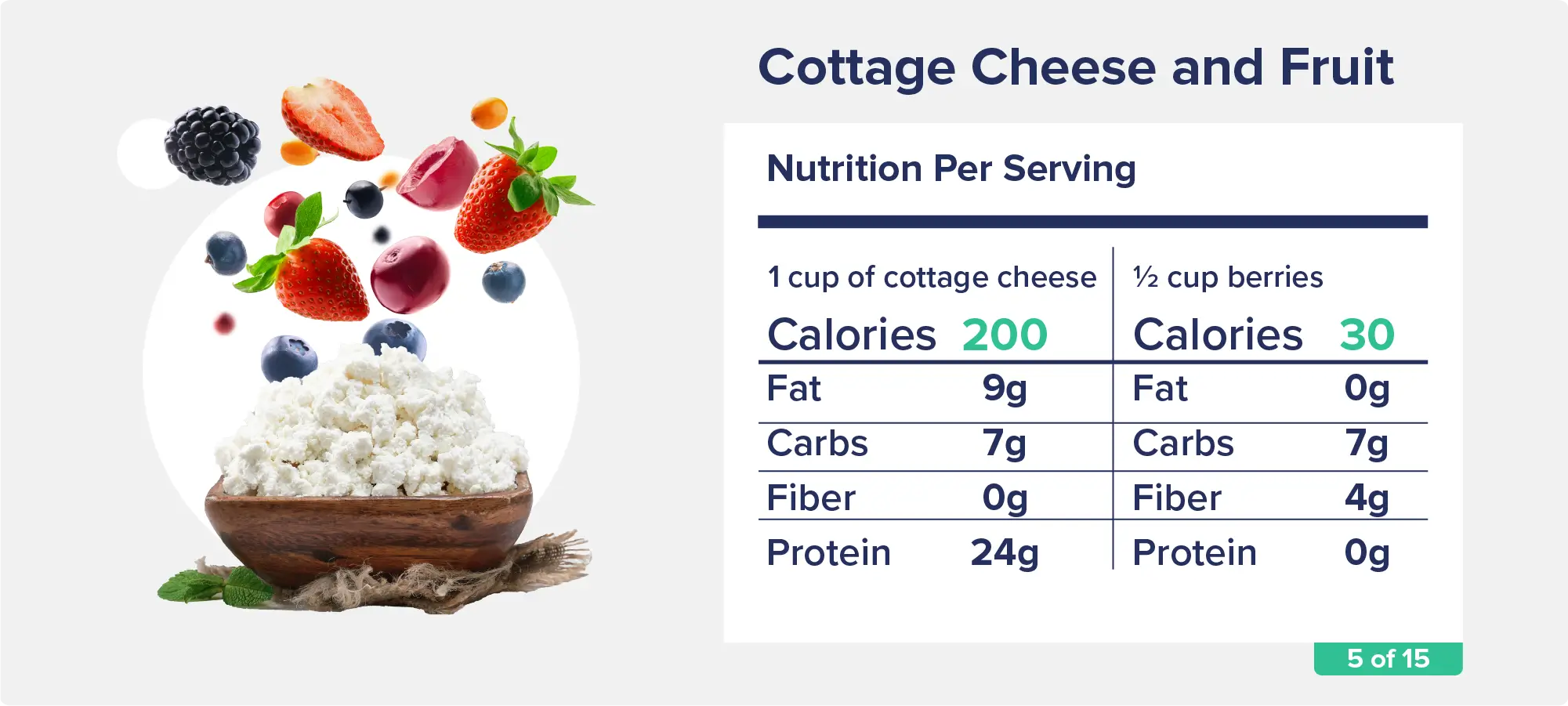
Avocado is rich in healthy fats, fiber, vitamin C, and potassium.
Although they are high in fat, the prominent type is monounsaturated fat—a heart-healthy form of fat that protects against cardiovascular and metabolic diseases.3
Guacamole may also contain onion, lime juice, tomato salsa, garlic, or cilantro, all of which provide additional nutrients and antioxidants.
If you’re watching your calorie intake, look for prepackaged guacamole cups (typically 2 ounces) and pair them with sliced bell peppers, carrots, jicama, sliced radishes, celery, or any other crunchy veggie you like.
Nutrition Per Serving:
2oz guacamole: 120 calories, 11g fat, 4g carbs, 3g fiber, 1g protein
2 cups of raw veggies: ~40 calories, 0g fat, 11g carbs, 3g fiber, 1g protein
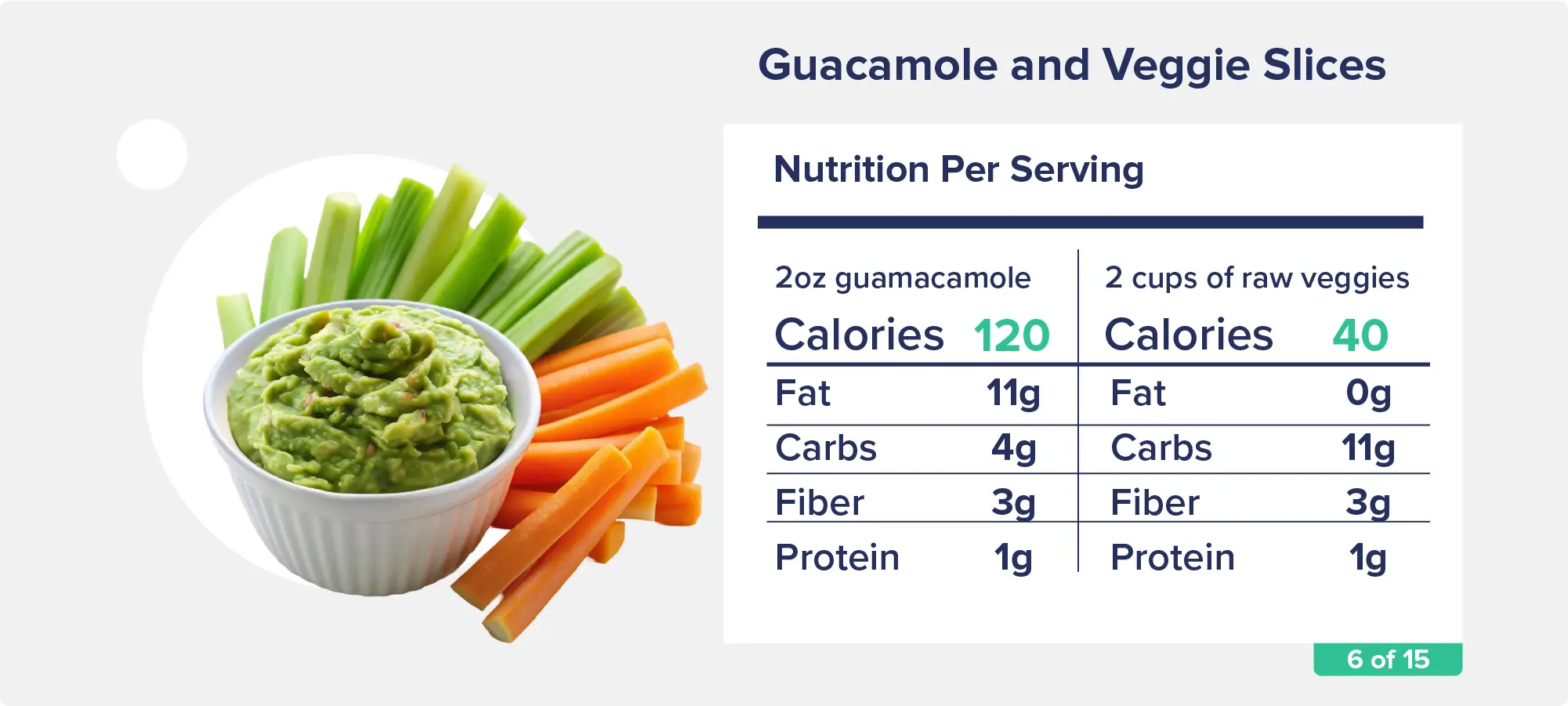
Like cottage cheese, Greek yogurt is extremely high in protein per ounce, and the fat level can be varied depending on your preferences and calorie goals.
If you want a more filling snack, opt for full-fat Greek yogurt. If you’d like to keep the calorie count lower, you can look for non-fat.
Greek yogurt is also a great source of bone-building calcium and gut-friendly probiotics.
Rather than choosing a sugary flavored Greek yogurt, mixing it with berries is a great way to boost your snack’s fiber and antioxidant content while providing natural sweetness from the fruit.
Blueberries and raspberries are two of the lowest-sugar berries, and both provide high levels of fiber and polyphenol compounds called anthocyanins, which reduce inflammation and may support healthy weight management.4
Nutrition Per Serving:
6oz of full-fat plain Greek yogurt: 140 calories, 8g fat, 5g carbs, 0g fiber, 14g protein
½ cup berries: ~30 calories, 0g fat, 7g carbs, 4g fiber, 0g protein
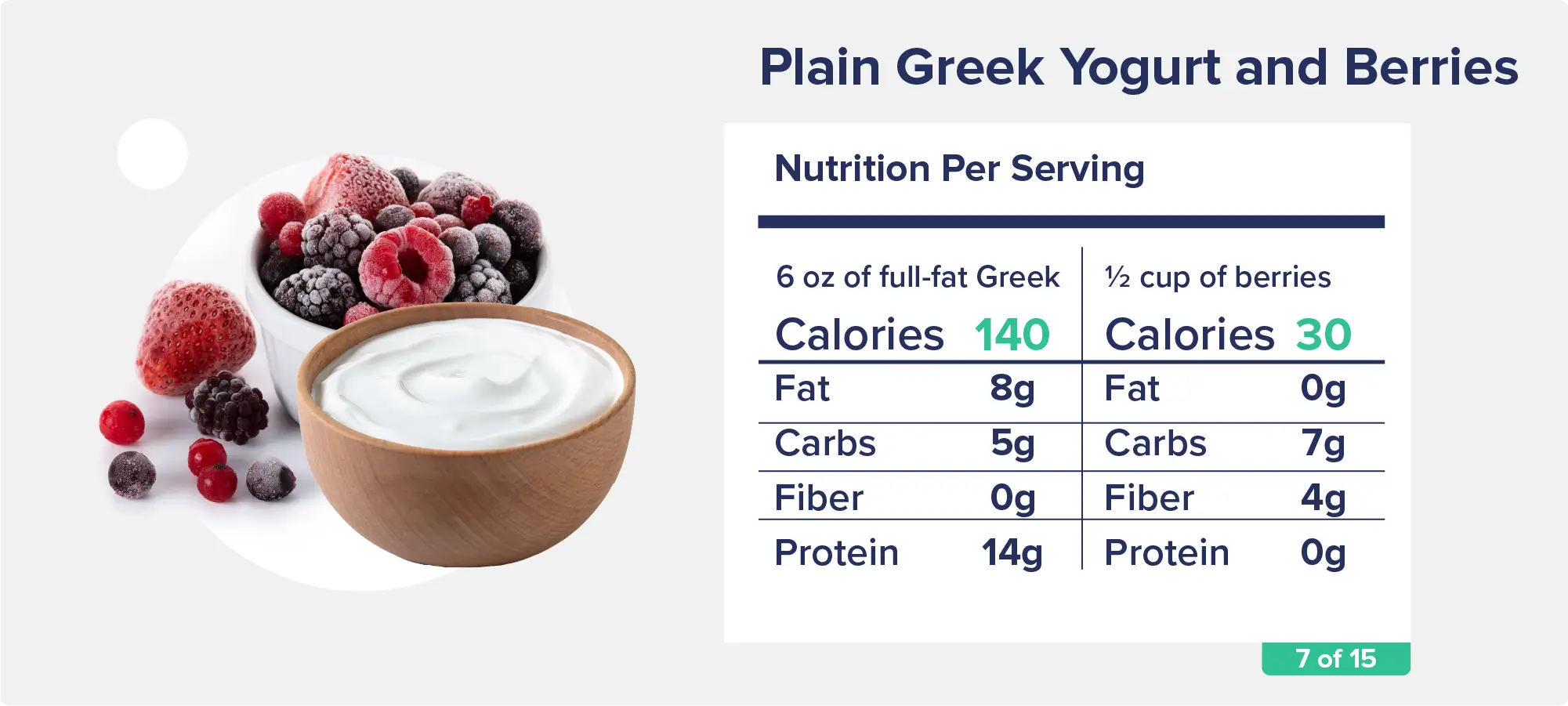
Popular in the keto and low-carb crowd, cheese-and-turkey roll-ups are a simple snack loved by people of all ages.
Although some roll-ups involve a tortilla wrapping the outside, this version uses sliced deli turkey to roll around the cheese to reduce the carbohydrates and calories.
Make two roll-ups by wrapping a slice or two of turkey around a mozzarella string cheese (split in half) or a slice of more pliable cheese. Another alternative is to spread cream cheese inside the turkey, although cream cheese has less protein.
Turkey and cheese are both high in protein, while cheese is higher in fat—and the combination makes for a satisfying snack.
Nutrition Per Serving:
3 slices of deli turkey: 75 calories, 0g fat, 0g carbs, 0g fiber, 17g protein
1 mozzarella string cheese or slice of cheese: 80 calories, 5g fat, 1g carbs, 0g fiber, 7g protein
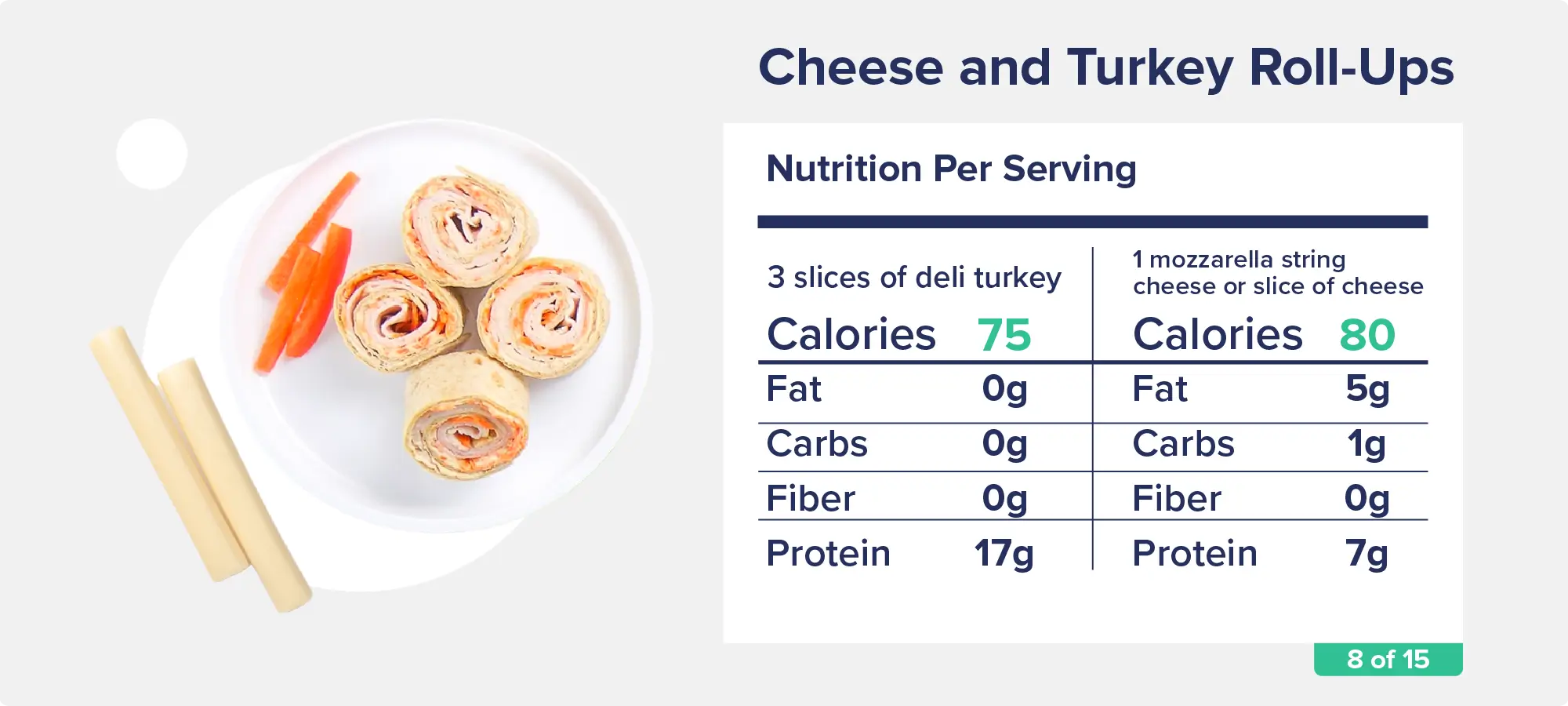
Commonly used in Mediterranean and Middle Eastern cuisine, hummus is a spread or dip made from chickpeas (garbanzo beans), tahini (sesame seed paste), olive oil, garlic, and herbs or spices.
Hummus is a hearty dip rich in fiber, unsaturated fats, and protein, making it perfect for a healthy and filling snack.
For a low-calorie snack, pair 2 tablespoons of hummus with 1-2 cups of sliced cucumbers, baby carrots or carrot sticks, sliced bell pepper, or sliced radishes into your hummus. You can also eat cherry tomatoes on the side, as they are a little harder to dip.
Nutrition Per Serving:
2 Tbsp of hummus: 50 calories, 3g fat, 4g carbs, 2g fiber, 3g protein
2 cups of raw veggies: ~40 calories, 0g fat, 11g carbs, 2g fiber, 1g protein
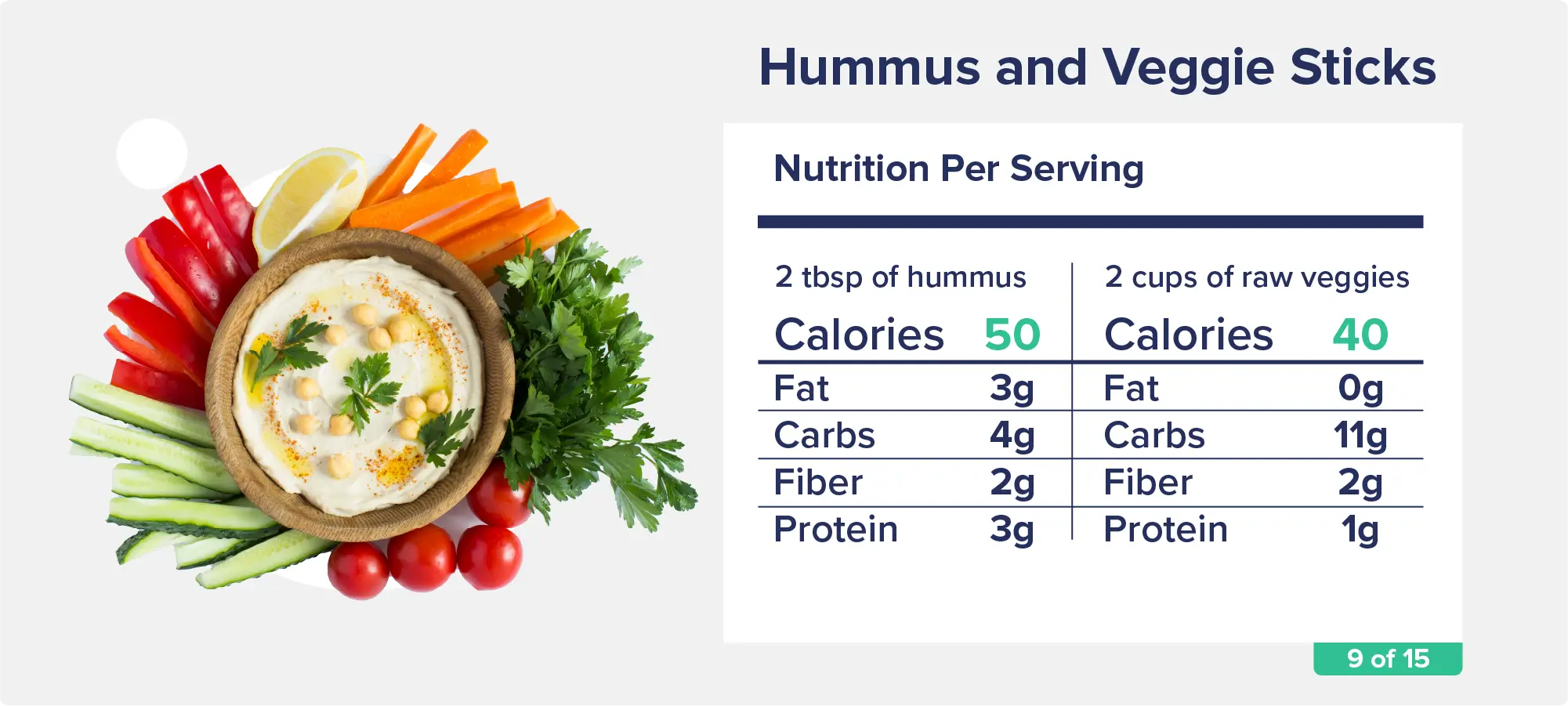
Healthy, high-quality meat sticks or beef jerky are all the rage in the wellness world right now. Many people have been searching for protein-rich snacks that aren’t gas station Slim Jims.
Healthy options typically have zero added sugar, are lower in sodium, and use meat from grass-fed or pasture-raised animals.
Some options we like include Chomps, EPIC, and Paleovalley, with various flavors and types of meat, ranging from beef to chicken to venison.
Meat sticks are mostly protein, but most also contain some healthy fat. With just 90 calories, this snack is on the lighter side—but the 9 or so grams of protein should help keep you satisfied for at least a little while.
Nutrition Per Serving:
1 meat stick: ~90 calories, 6g fat, 0g carbs, 0g fiber, 9g protein
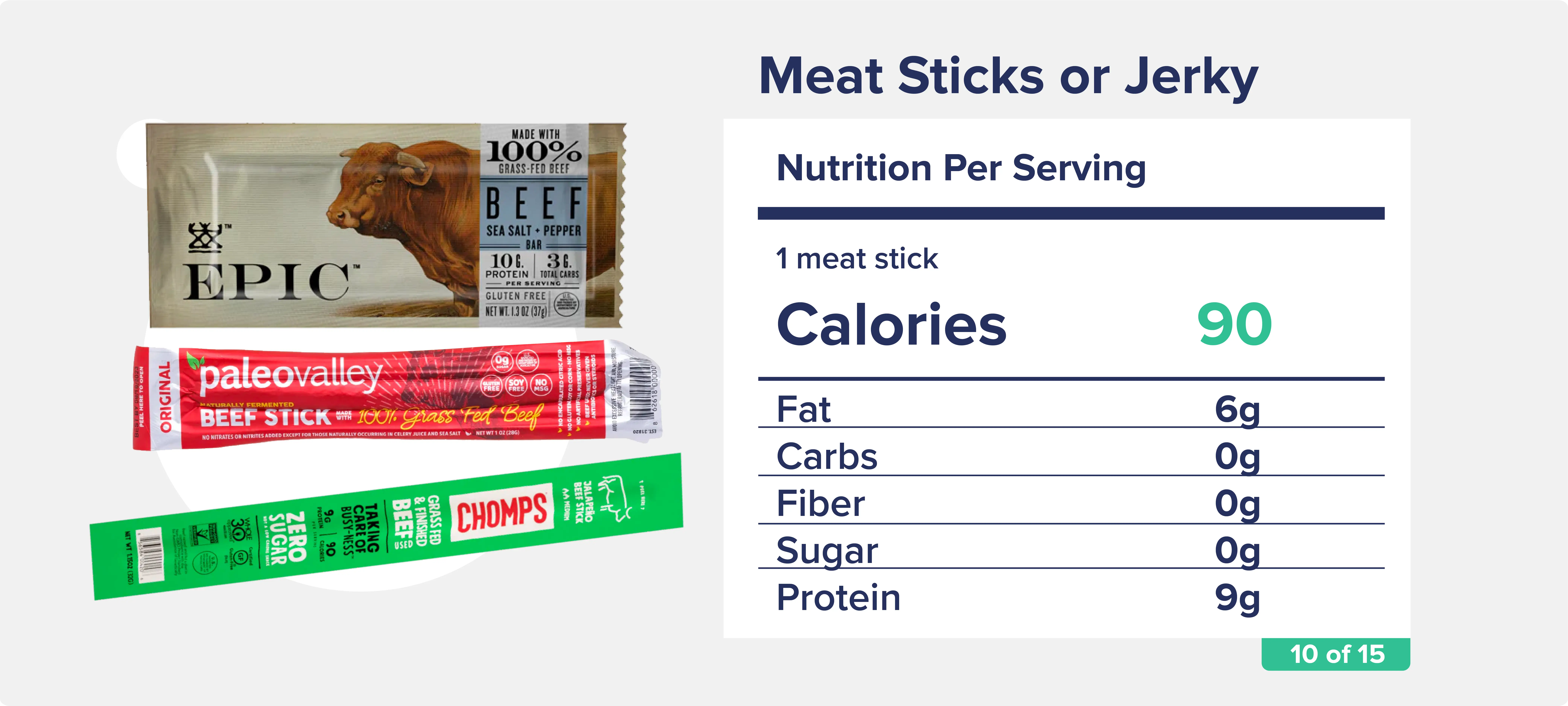
Bone broth is made by slow simmering the bones or connective tissue of animals (typically cows or chickens) for hours or days.
This process allows the collagen, protein, and nutrients to be absorbed into the hot water, creating a nutritious broth with much more protein than a typical chicken or beef broth.
Bone broth can vary in protein content, but it typically contains about 10 grams per cup. As bone broth is a liquid, it’s less satiating than eating 10 grams of food-based protein. Consider bone broth a mini snack, or double the serving size and drink 16 ounces.
Most grocery stores now carry bone broth—read about our favorites in this review of the 8 best bone broths we’ve tried this year here.
Nutrition Per Serving:
1 cup of bone broth (8oz): ~40 calories, 0g fat, 0g carbs, 0g fiber, 10g protein
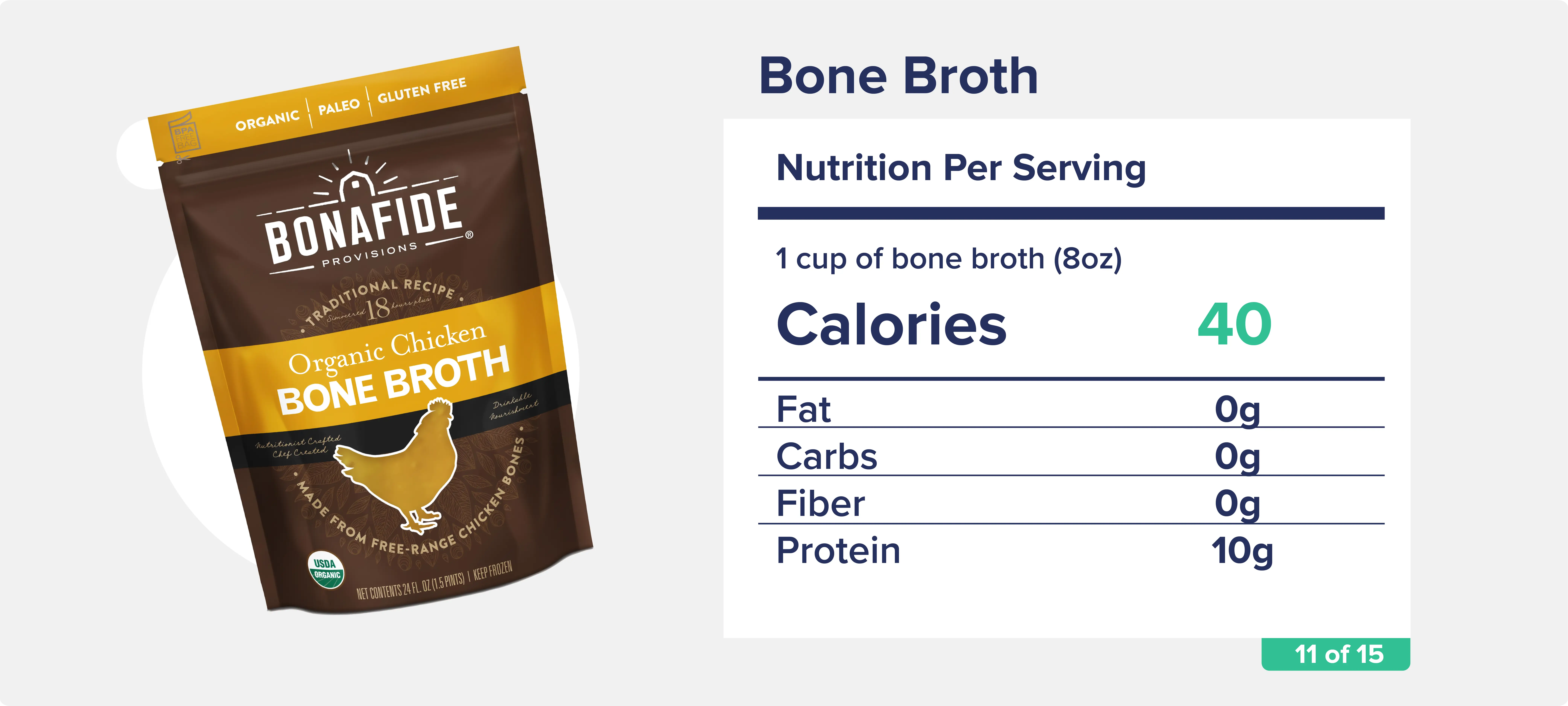
Edamame are immature soybeans usually eaten straight out of the pod, making for a tasty and nutritious snack.
Half a cup of shelled edamame contains 95 calories. As edamame is in the legume family, it is rich in fiber (8 grams of fiber per cup) and contains plant-based protein (17 grams per cup!).
This legume also contains 8 grams of healthy, predominantly monounsaturated fat per cup.
Plus, removing edamame from their pods takes longer to eat, which prolongs the snacking experience and helps with satiety.
Edamame are delicious on their own, dipped in soy sauce, or sprinkled with sea salt.
Nutrition Per Serving:
1 cup cooked edamame (shelled): 190 calories, 8g fat, 15g carbs, 8g fiber, 17g protein
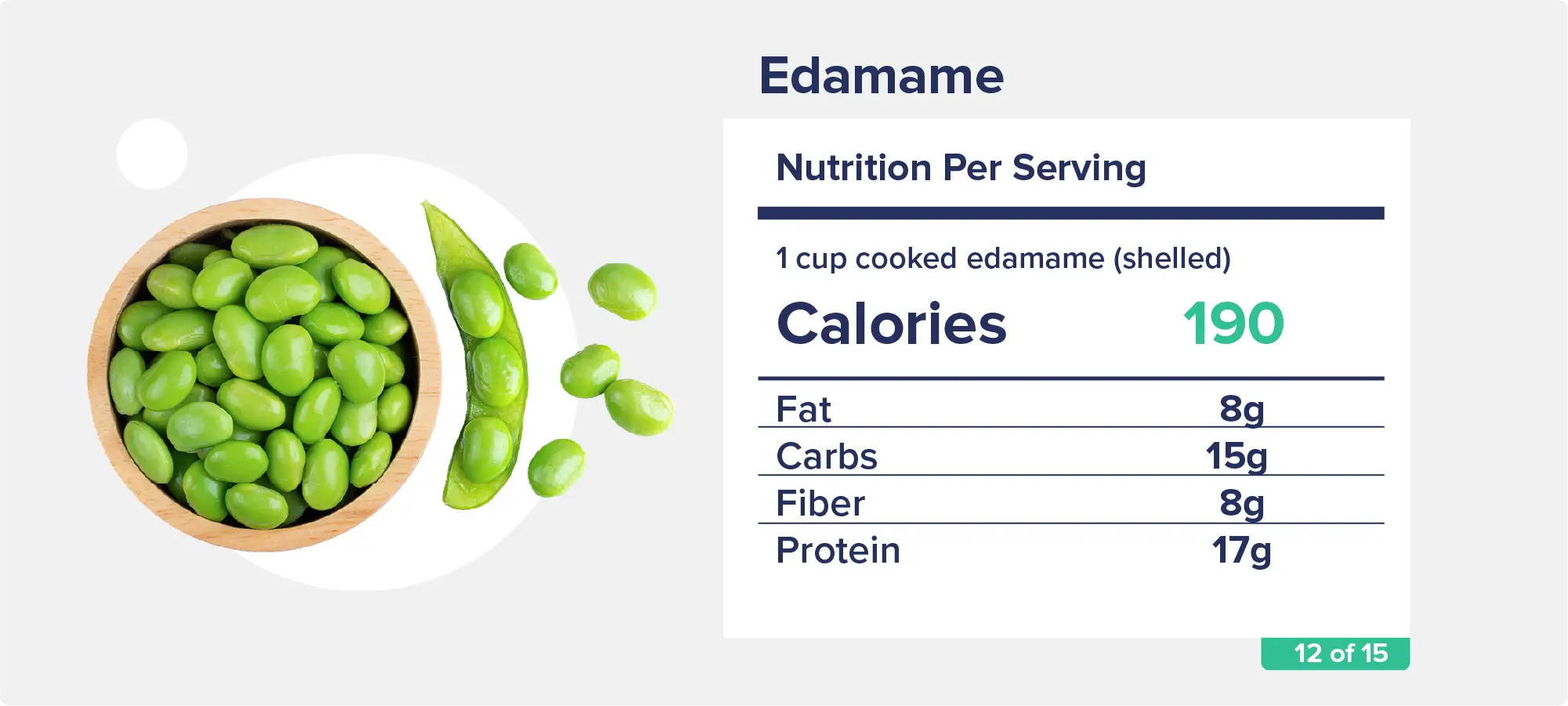
Nuts are high in monounsaturated fat, vitamin E, magnesium, and selenium, and berries are rich in antioxidants and fiber.
Although nuts are high in calories and fat, research shows that moderate nut consumption can increase satiety, lower inflammation, and reduce the risk of chronic diseases like cardiovascular disease and obesity.5
While all nuts are healthy, pistachios are great because you can have a greater quantity of them (25 pistachios for 80 calories!). Like with edamame, it takes longer to eat if they are in their shells, lengthening the snacktime and helping with fullness.
Nutrition Per Serving:
25 pistachios: 80 calories, 7g fat, 3g carbs, 1g fiber, 3g protein
½ cup berries: ~30 calories, 0g fat, 7g carbs, 4g fiber, 0g protein
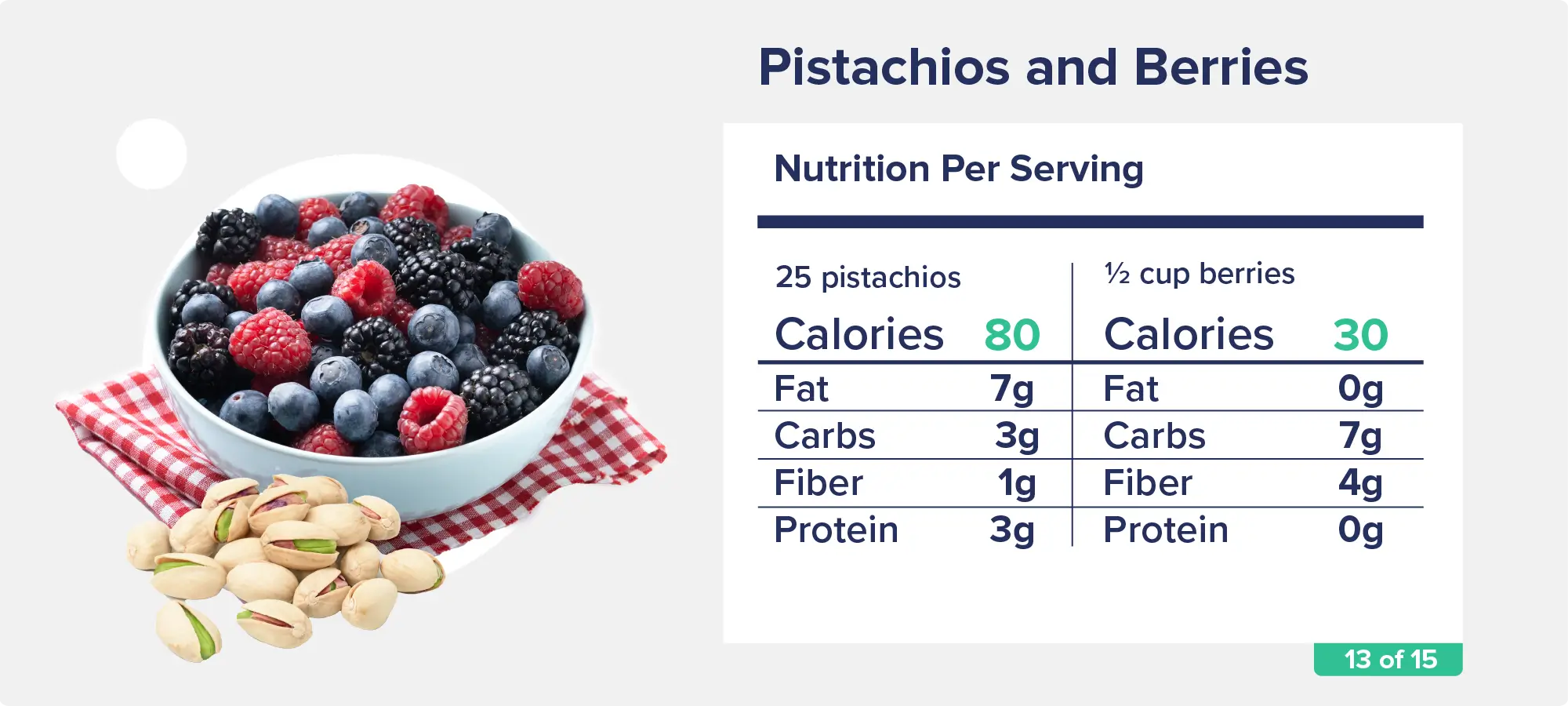
If you’ve never had chicken chips before, they certainly don’t sound too appetizing—but trust us, you want to try them.
Our favorite chicken chip brand is WILDE Chips, which taste so much like regular chips that you’ll never know the difference—except when you start to actually get full because they’re so loaded with protein.
With WILDE, you can eat 20 chips for 170 calories and 10 grams of protein (plus way fewer carbs than regular chips!).
Nutrition Per Serving:
20 chicken chips (WILDE brand): 170 calories, 10g fat, 8g carbs, 2g fiber, 10g protein
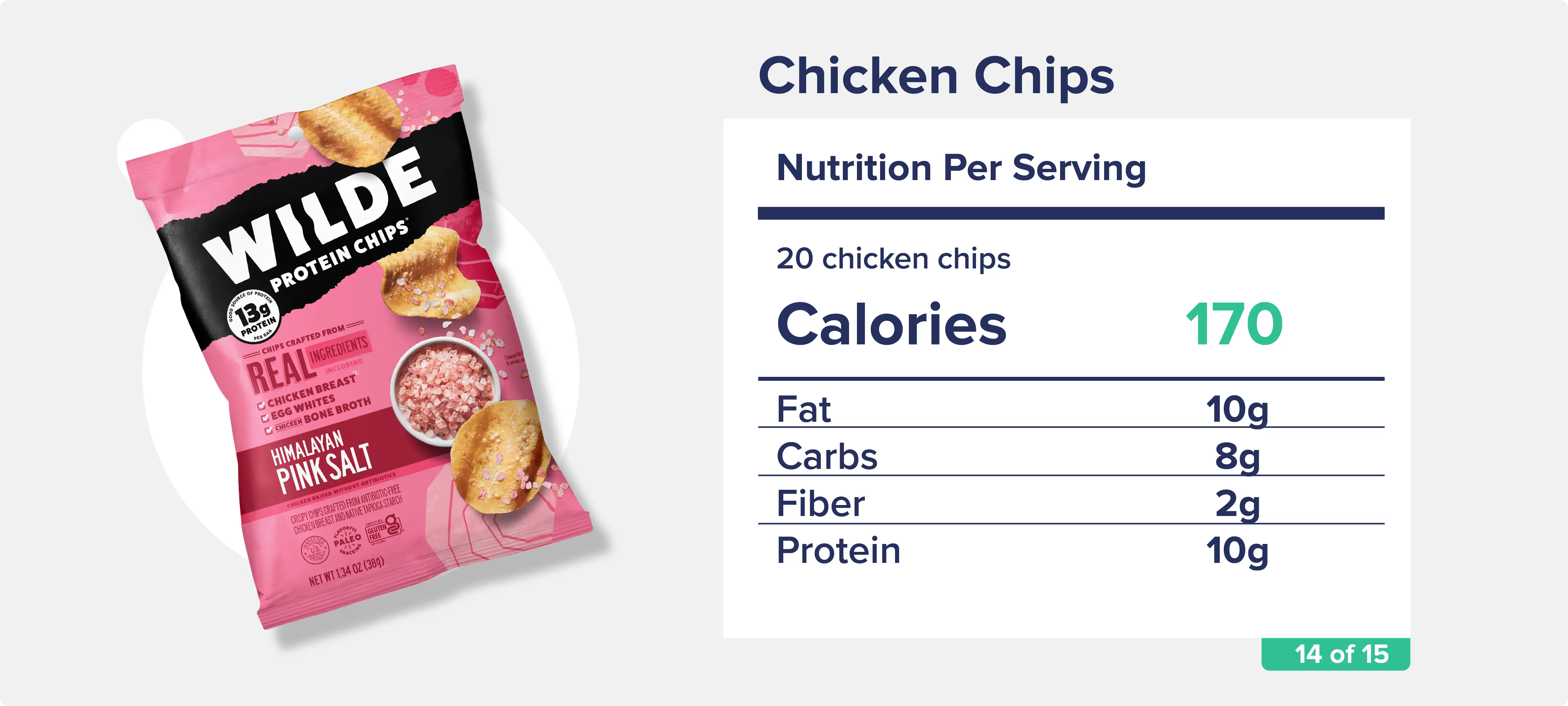
A protein shake is pretty simple: just protein powder and water. Most protein powders are, unsurprisingly, predominantly protein but may also contain a bit of fat, carbs, and fiber.
However, many people like to jazz it up a bit. Some other options are mixing with milk or nut milk or blending protein powder with some fruit, nut butter, Greek yogurt, or greens (like spinach or kale). Of course, these other options will increase the calorie count.
For everything you’d ever want to know about making protein shakes, check out this article.
Nutrition Per Serving:
1 serving protein powder: ~130 calories, 3g fat, 5g carbs, 2g fiber, 20g protein
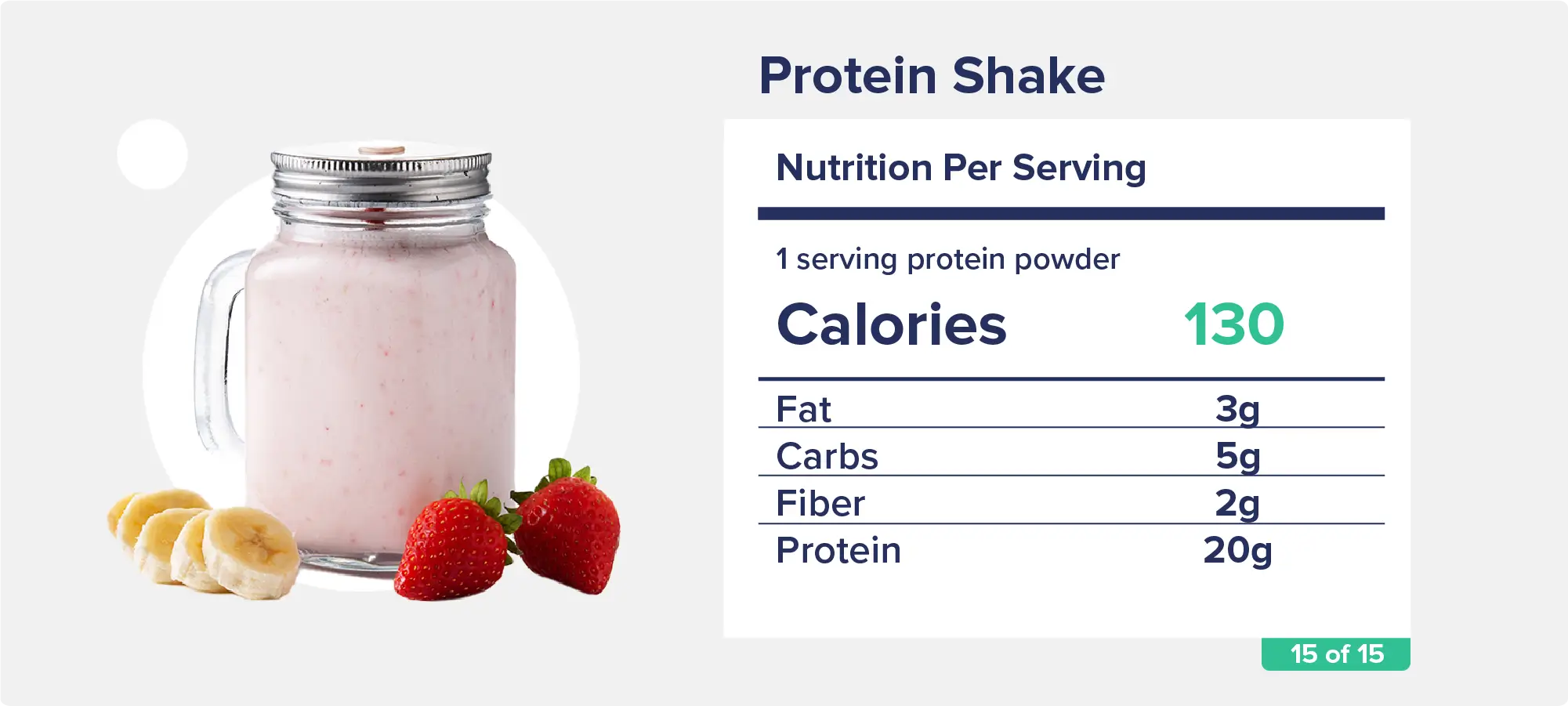
The number of calories in a snack will vary widely depending on your total daily caloric needs, which are primarily based on your age, sex, and activity level.
In general, a typical snack might be anywhere from 150-300 calories, with the lower end likely only being satiating enough if it’s almost entirely protein (like a protein shake or jerky).
It might take some trial and error to find out the “right” number of calories for your snack. It should satiate you for a couple of hours, but not so much that you are not hungry when your next meal rolls around. Keep in mind that it’s typically easier to overconsume foods high in refined carbohydrates and low in fiber and protein (like potato chips, crackers, and other snack foods). These foods are much less filling than snacks rich in fiber, protein, and healthy fats.
Healthy low-calorie snacks include vegetables (especially celery, radishes, greens, lettuce, cherry tomatoes, and cucumber), non-fat dairy (like Greek yogurt and cottage cheese), bone broth, hard-boiled eggs, and air-popped popcorn.
No, zero-calorie or negative-calorie foods do not exist. Many people claim that foods like celery are a “negative calorie food,” meaning your body expends more calories to digest it than are actually in the food itself. However, that’s not entirely true. The energy needed to digest, absorb, and metabolize foods (known as the “thermic effect of foods”) is about 5-10% of the calories that food contains for carbs, 0-5% for fat, and up to 30% for protein.2 For example, if you eat 100 calories of celery, you’d only expend 5-10 calories of that in the digestion and absorption process, as celery is mostly carbohydrates.
Low-calorie snack ideas that are still filling include:
• Hard-boiled eggs
• Air-popped popcorn
• Canned tuna
• Greek yogurt
• Cottage cheese
• Hummus and veggies
• Guacamole and veggies
• Pistachios and berries
• Protein shakes
• Chicken chips
• Edamame
• Meat sticks
• Jerky
• Celery and nut butter
• Bone broth
There is no “number one” best food for weight loss. However, many healthy foods can support weight management, including lean proteins (like fish, chicken, and eggs), vegetables, dairy, low-sugar fruits (like berries), and healthy fats (like avocado and olive oil).
If you crave junk food, it can be helpful to identify which type of food you’re craving (i.e., salty, sweet, spicy, crunchy, etc.). If you are craving potato chips or pretzels, try roasted nuts or chickpeas, which have more protein and fiber than chips. If you’re craving sugary desserts, try eating fruit or dark chocolate. Throughout your day, consuming a diet rich in protein and fiber can keep you more full and satisfied and reduce hunger hormones, which leads to fewer cravings.